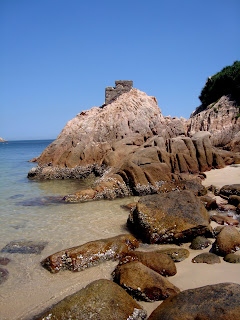 Imagining a more mythic journey of my Grandfather when he left his home in China for better opportunities in the United States, and specifically New York City.
Imagining a more mythic journey of my Grandfather when he left his home in China for better opportunities in the United States, and specifically New York City.
Monday, August 24, 2009
Gong Gong Comes to New York
 Imagining a more mythic journey of my Grandfather when he left his home in China for better opportunities in the United States, and specifically New York City.
Imagining a more mythic journey of my Grandfather when he left his home in China for better opportunities in the United States, and specifically New York City.
Sunday, August 23, 2009
Pics of the Day 09: Dragon's Back and Shek O Beach
Saturday, August 22, 2009
Pics of the Day 08: More Sham Shui Po
I have really grown to like this area, which feels like a throw-back to the past. There were some gems of buildings that looked like colonial era (maybe the 20s and 30s?) that are rare to find on Hong Kong island.
Saturday, August 15, 2009
From Electric Road to North Point
Tuesday, August 11, 2009
Pics of the Day 07: A Reminder of Home...

Friday, August 7, 2009
Stich by Stitch...
Thursday, August 6, 2009
Pics of the Day 06: A Walk Down Chun Yeung Street

A walk down the Chun Yeung Street outdoor market, one street up from the building where my Mom's family used to live in North Point. I took a photograph of every single shop along the north side of the street, starting on the eastern most corner of the street and moving west. I finished just as a downpour started, leftovers from yesterday's typhoon.
Monday, August 3, 2009
Sunday, August 2, 2009
Pics of the Day 05: Shek Kip Mei Housing Estates Visit
 The Mei Ho House was one of the first public housing projects the Hong Kong government undertook in 1954, as a response to the devastating fires that leveled thousands of homes in the squatter village in December of 1953. The public housing estates were an answer to the overwhelming numbers of refugees that swelled Hong Kong's population by millions in the early 1950s. It provided shelter in fire-proof structures, albeit small and not so design-friendly.
The Mei Ho House was one of the first public housing projects the Hong Kong government undertook in 1954, as a response to the devastating fires that leveled thousands of homes in the squatter village in December of 1953. The public housing estates were an answer to the overwhelming numbers of refugees that swelled Hong Kong's population by millions in the early 1950s. It provided shelter in fire-proof structures, albeit small and not so design-friendly. I

Faded peeling paint. Balconies facing outwards, long corridors. Geometrical, simple. Six stories. No elevators. Gates and bars.
Hot sun beating down.
Visitors with big professional cameras. One man takes our picture. Concrete, concrete concrete. Nothing soft or organic left. A hard empty shell.
In the first flat, crowded with people taking photos. The apartment is a small rectangular box.
The front door a faded mustard yellow. A tiny bathroom, big enough for a sink and toilet off to the right just inside the entrance. A front window. White walls, no windows except all the way in the back, coming in through the window/kitchen.
Things from decades ago..the 60s, the 70s? Plastic flowers. Ovaltine. A ceramic statue of Guan-Yin, Chinese goddess of mercy. A Chinese bible of sorts. A bright green mini-fridge. Very 70s. Horlicks. Thermoses. A cassette player and cassette tapes. The linens, table cloths, dresser covers, none of it matches. Things just there, randomly, but all necessities. Nothing is decorated, just put together. An old tv. An old radio. An old calendar, time frozen. Old tin cans hold nothing. Small beds, folding tables, folding chairs. Plastic coverings, plastic for protection.
We meet a woman, she and her husband speaks English. She looks to be in her 50s. She has come to the Mei Ho House because she was born there. They still live in Hong Kong, out in New Territories. The house she grew up in is not open to the public. It must be a very special feeling to be back. She remembers playing outside with her friends, but I don’t think she remembers much.
The corridors are long and empty, but once they must have been filled with children running up and down the corridors. Parents who walked home from a long day of work at a factory. Grandparents and elderly, joints stiff, backs aching, slowly shuffling down, one step at a time. There is no rush. Time is still.















